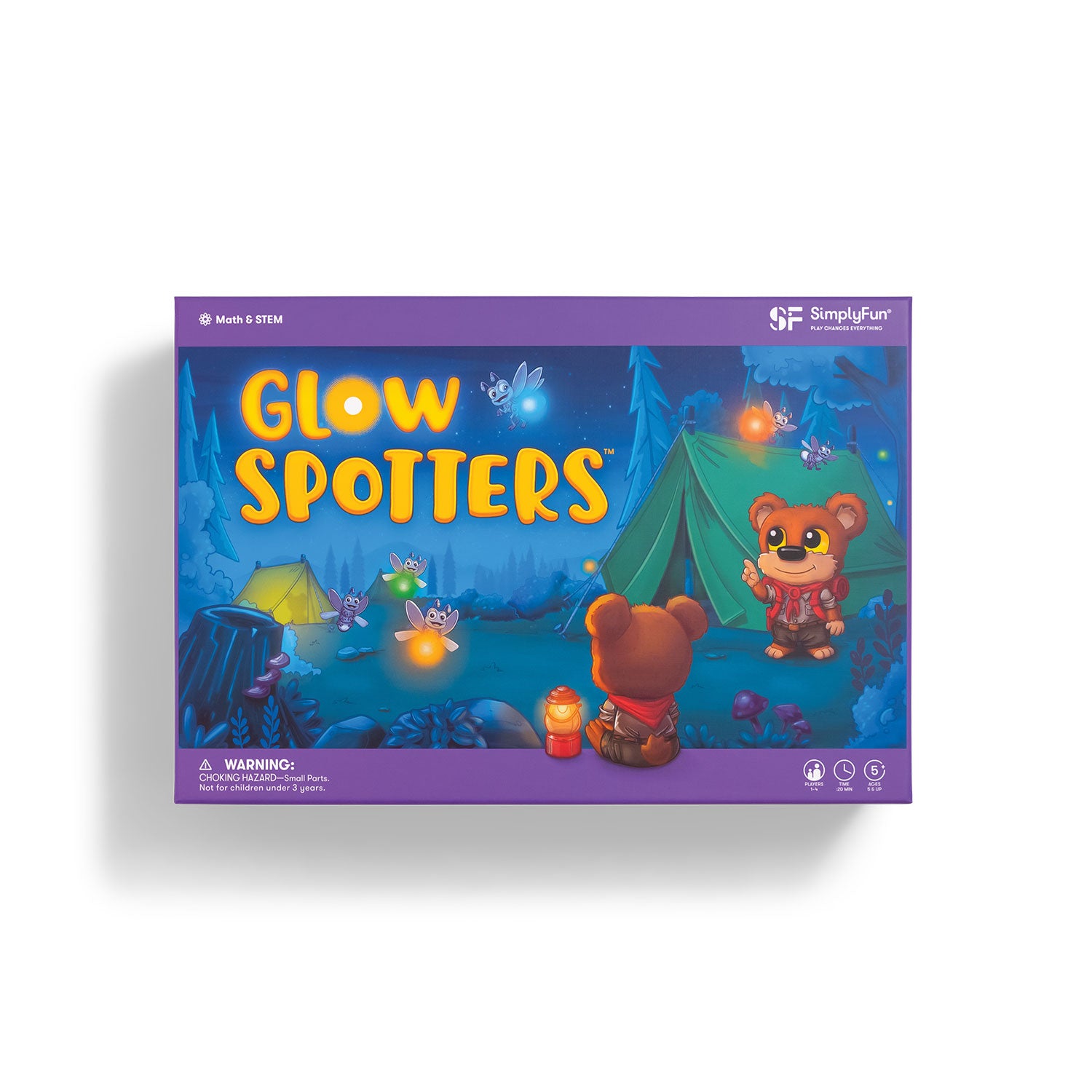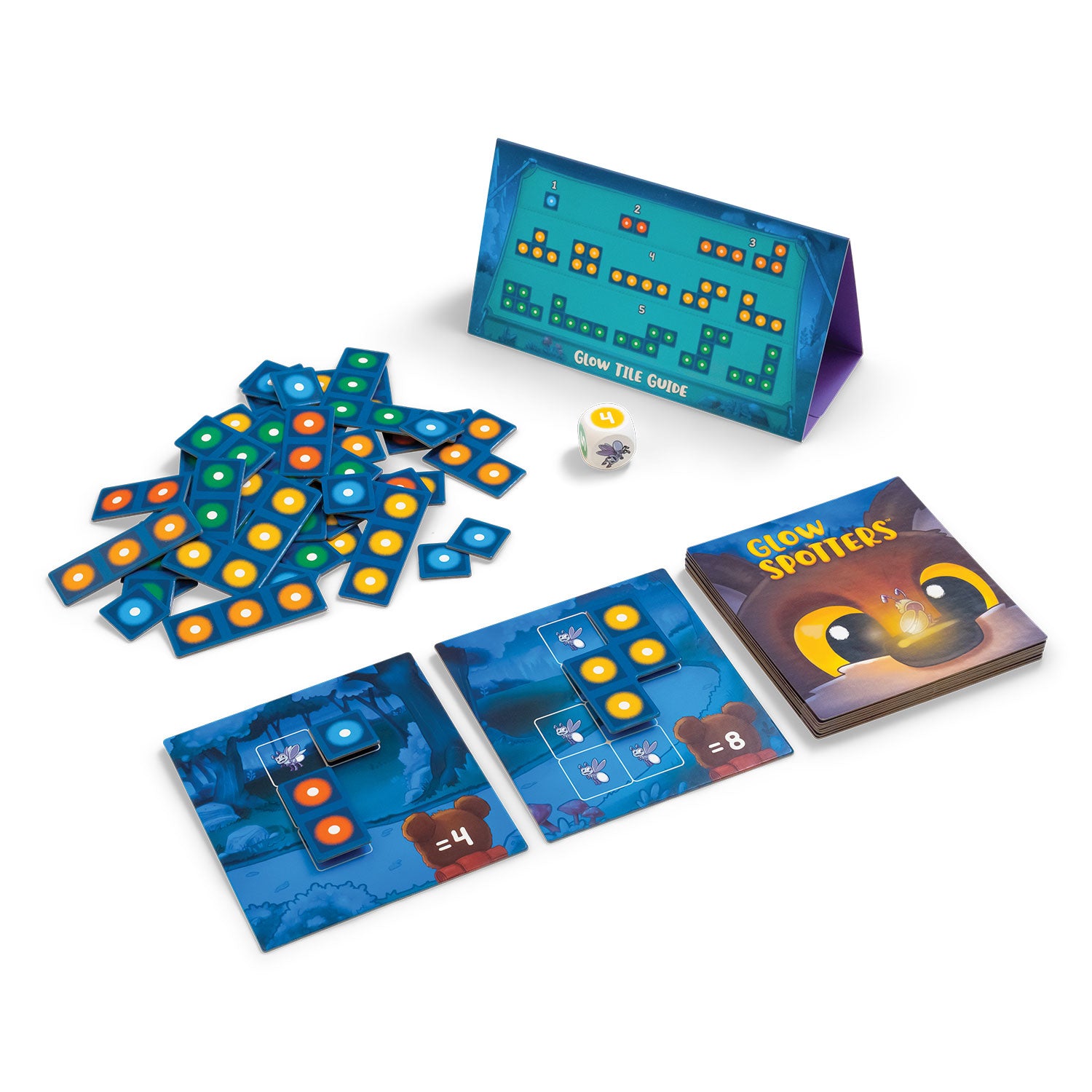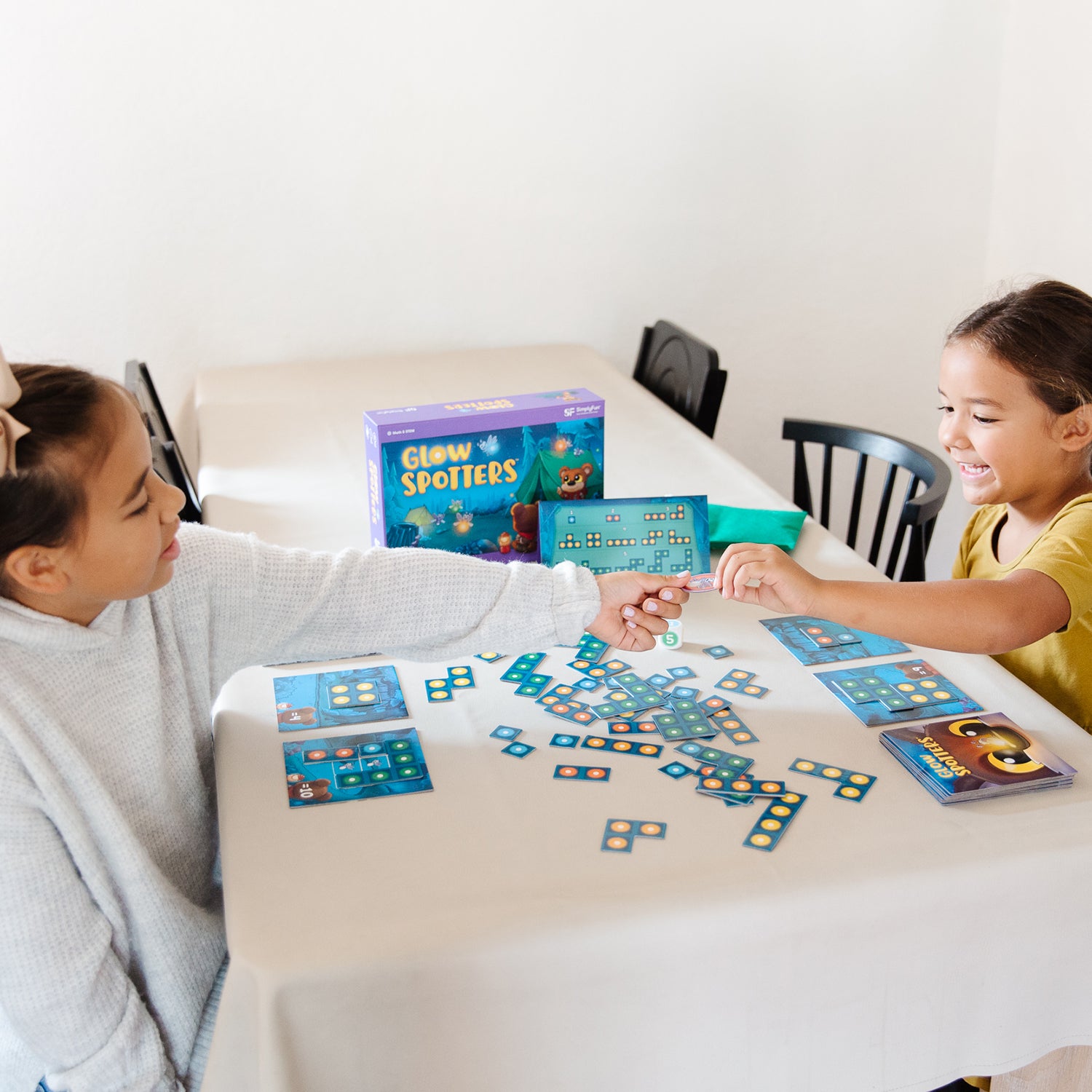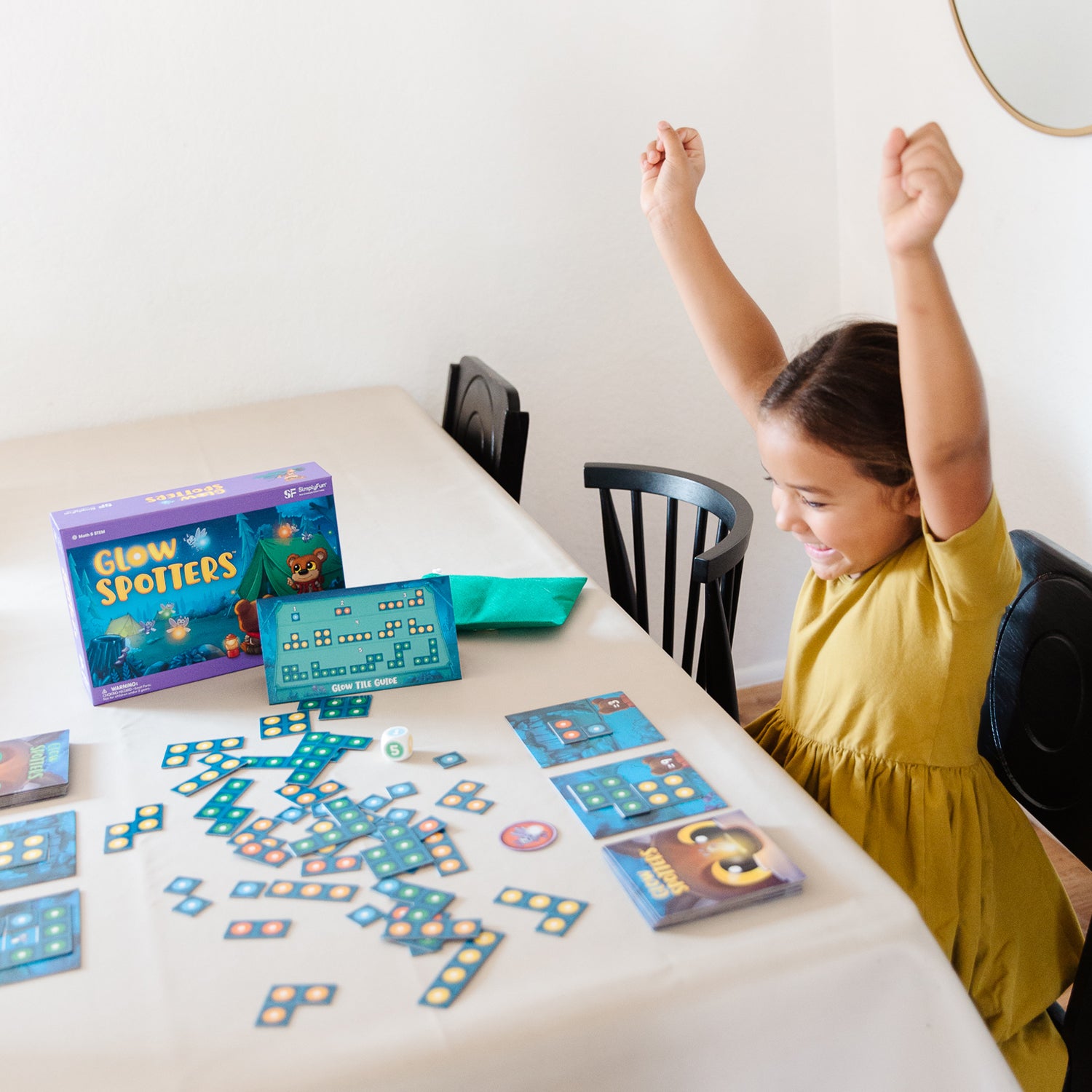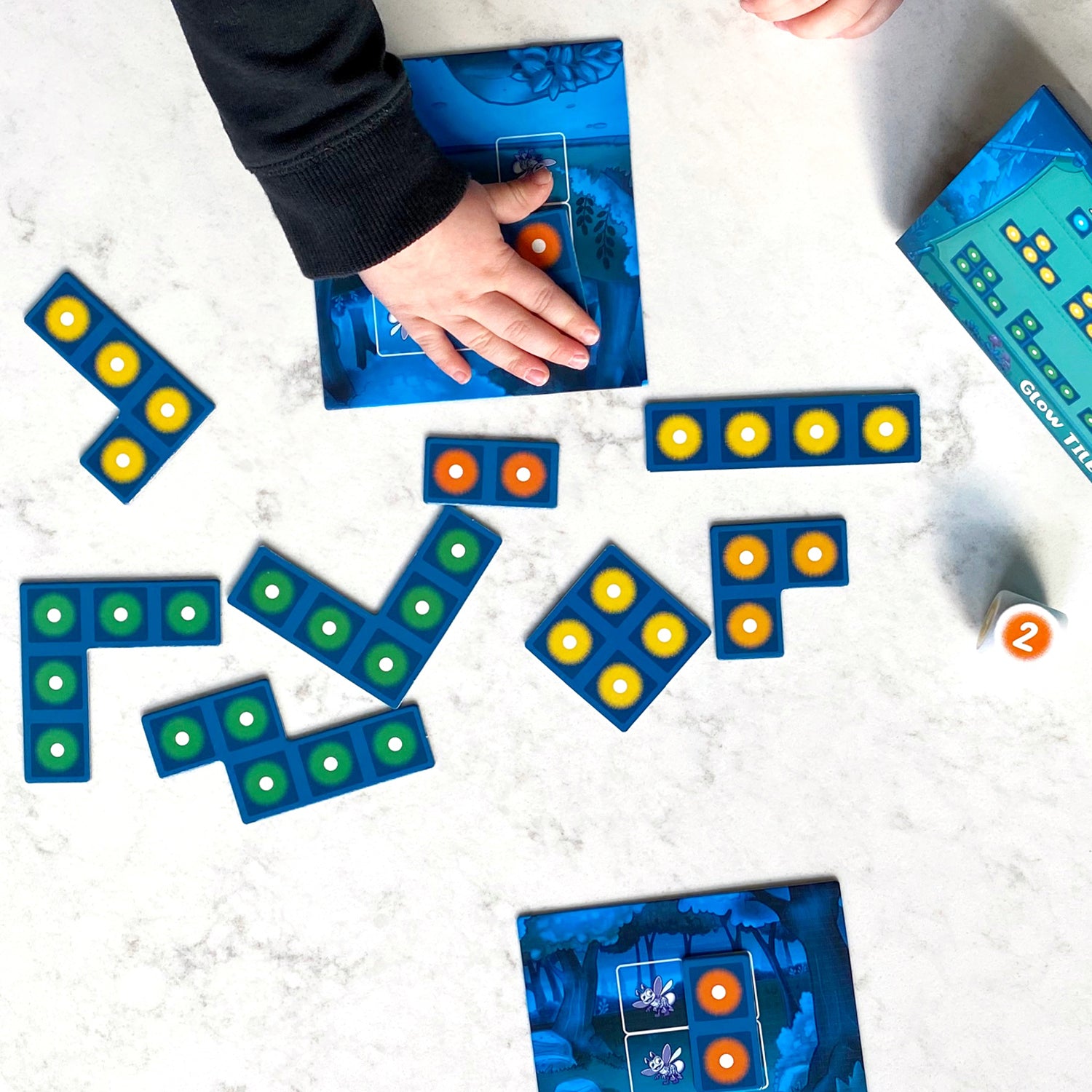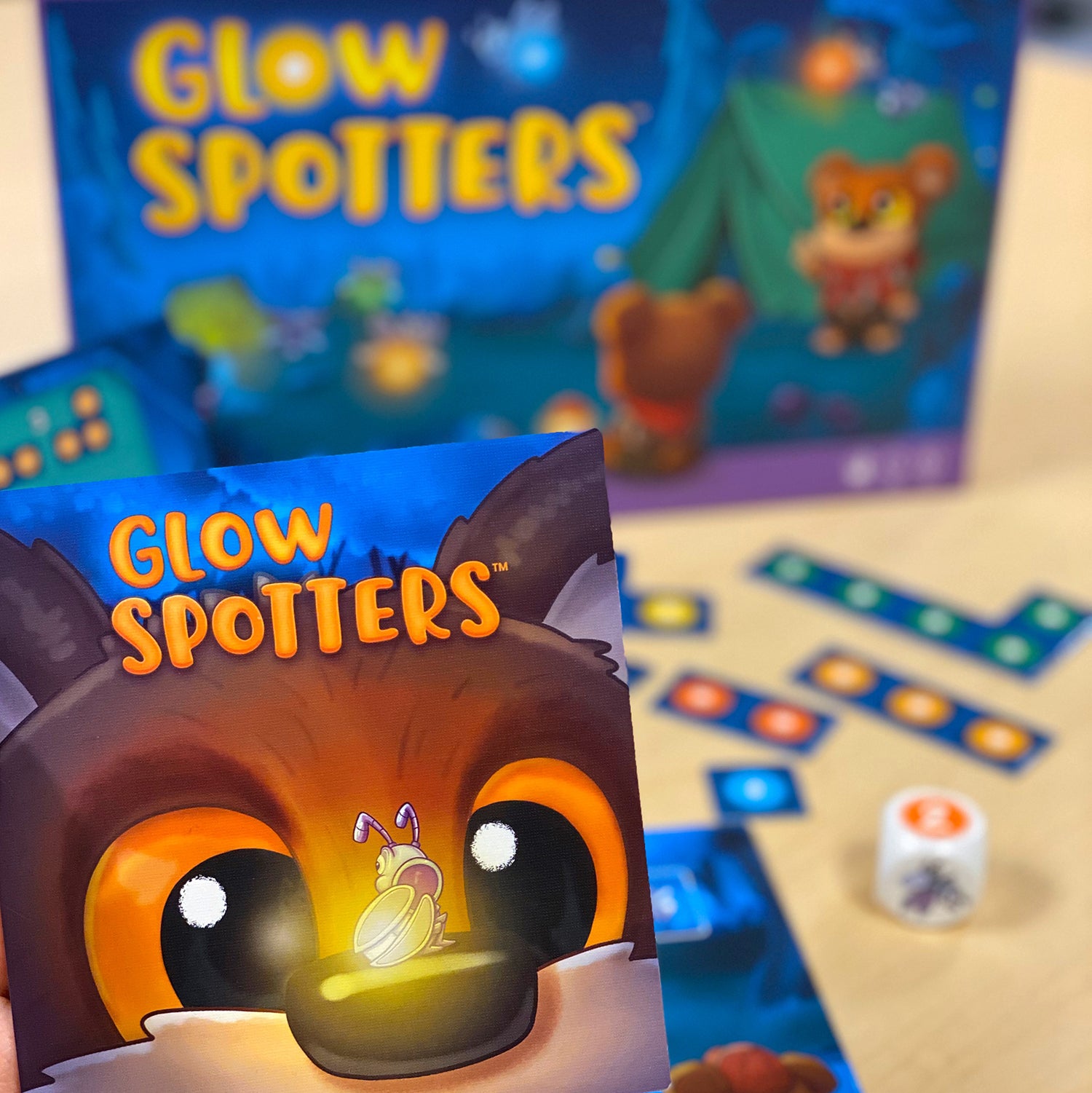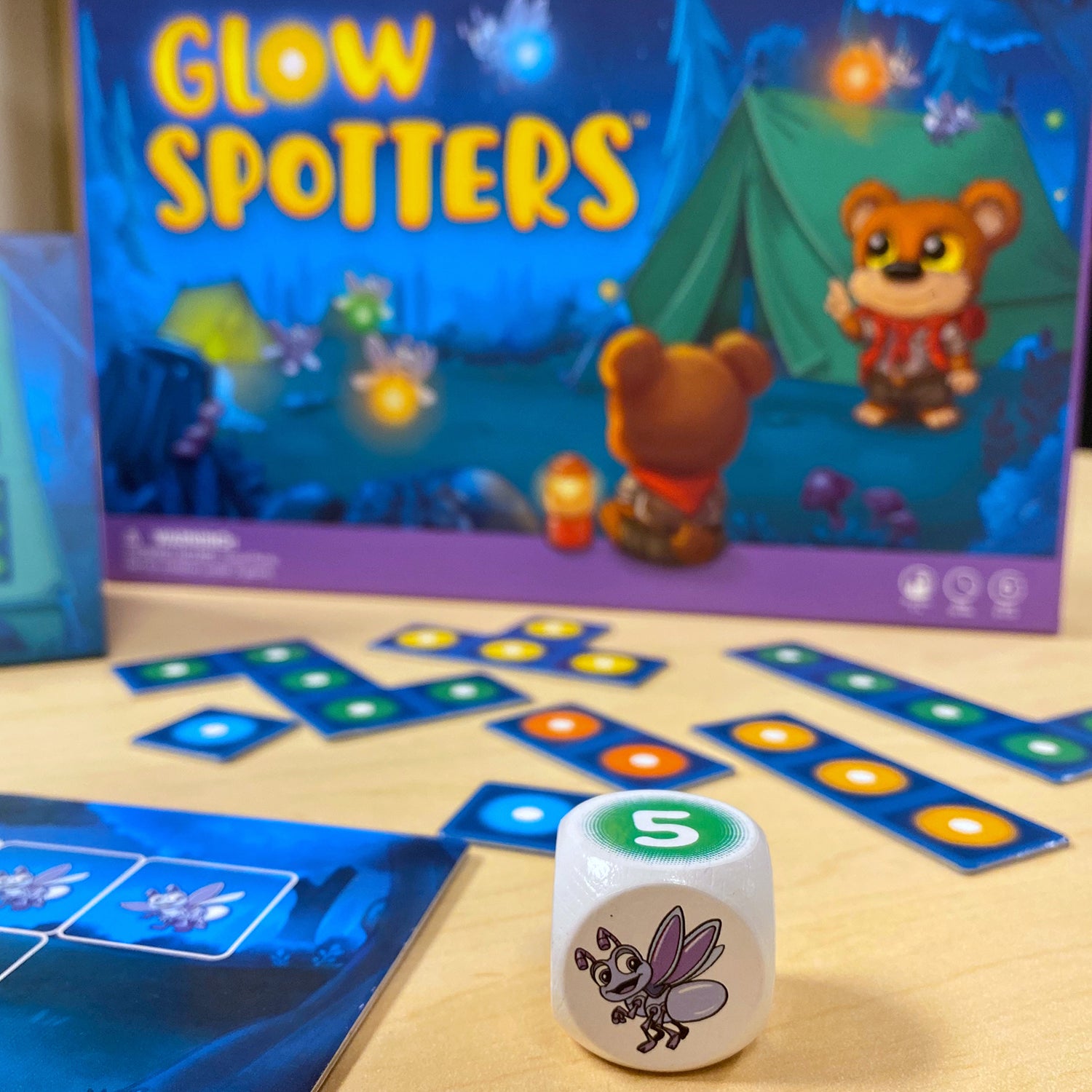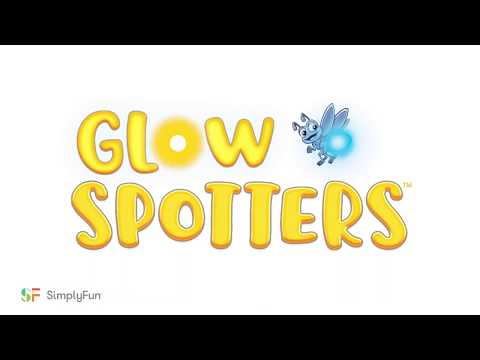Glow Spotters
Glow Spotters
1-4 players • 20 min • 5 & up
Focus: Addition
Couldn't load pickup availability
The Glow Spotters Troop is on a nature adventure, trying to count fireflies to earn their Firefly badges. Each player has a set of firefly boards numbered 1 to 10. Players roll the die and collect various-shaped glow tiles to reach the sum of fireflies on their boards. The first player to complete all their boards wins the game and receives their Firefly badge.
Skills: Addition, Spatial Reasoning
Game Includes
Game Includes
- 49 Glow Tiles (double-sided)
- 40 Firefly Boards
- 1 Six-Sided Die
- 1 Firefly Badge
- 1 Reference Guide
- 1 Storage Bag
- 1 Rules Booklet
Share
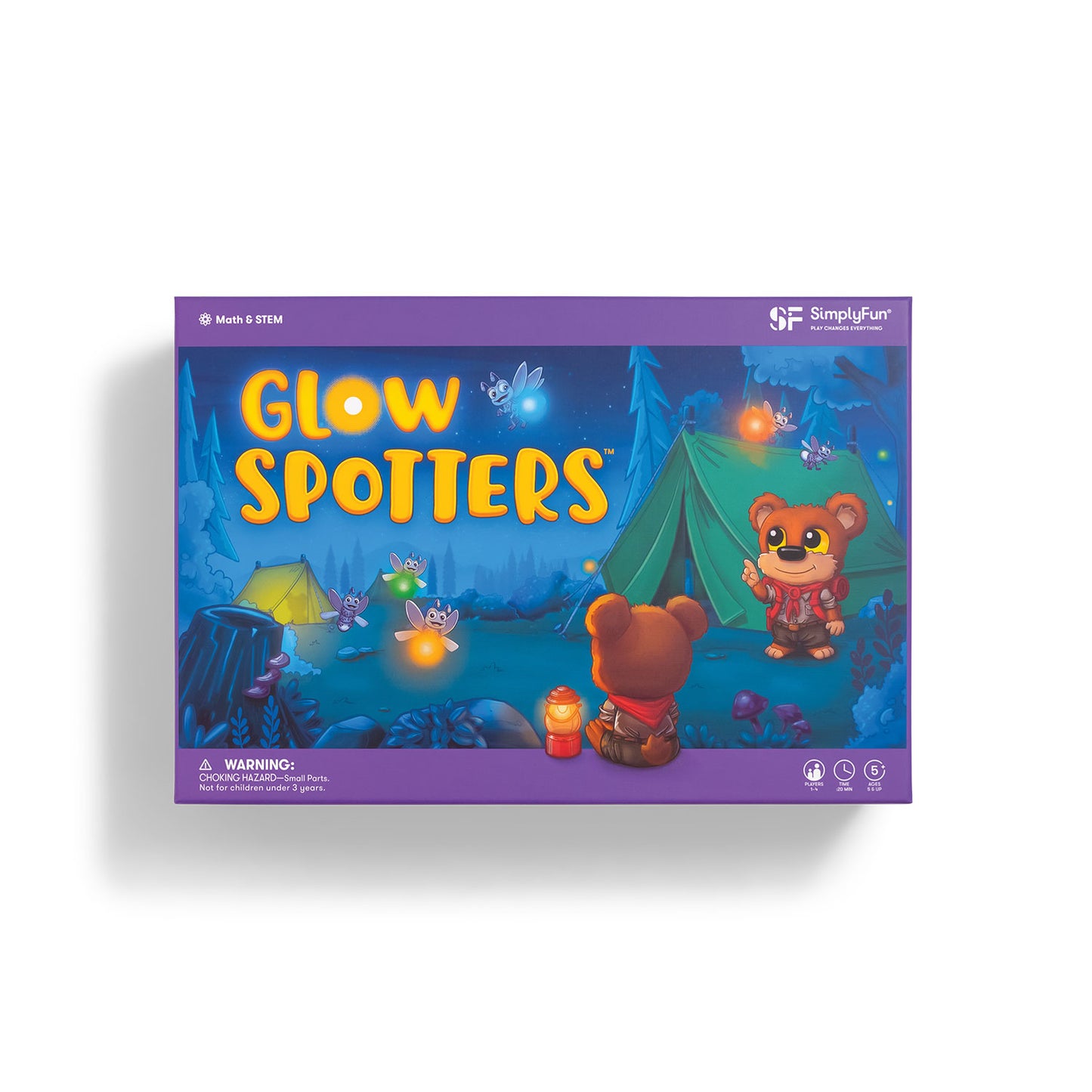
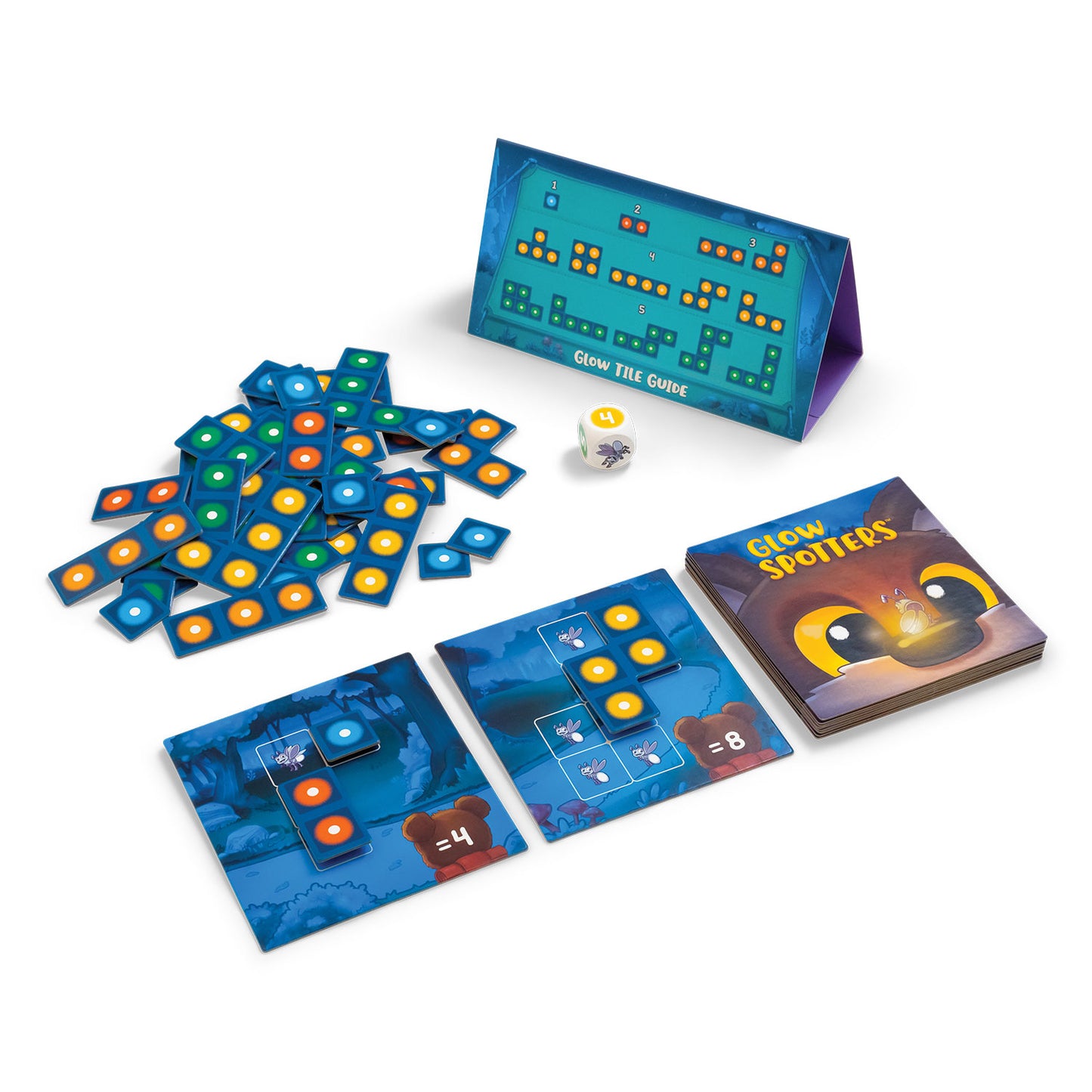
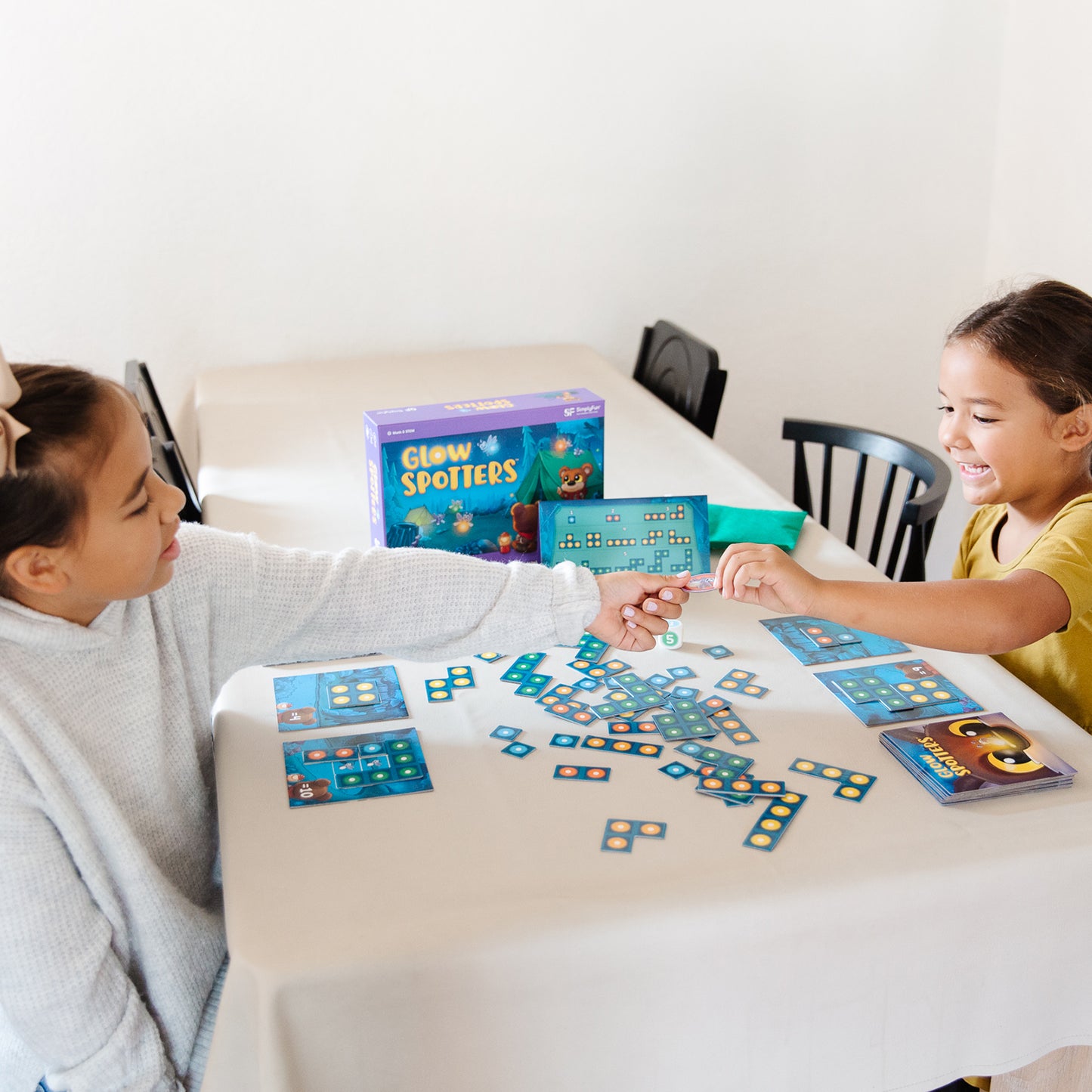
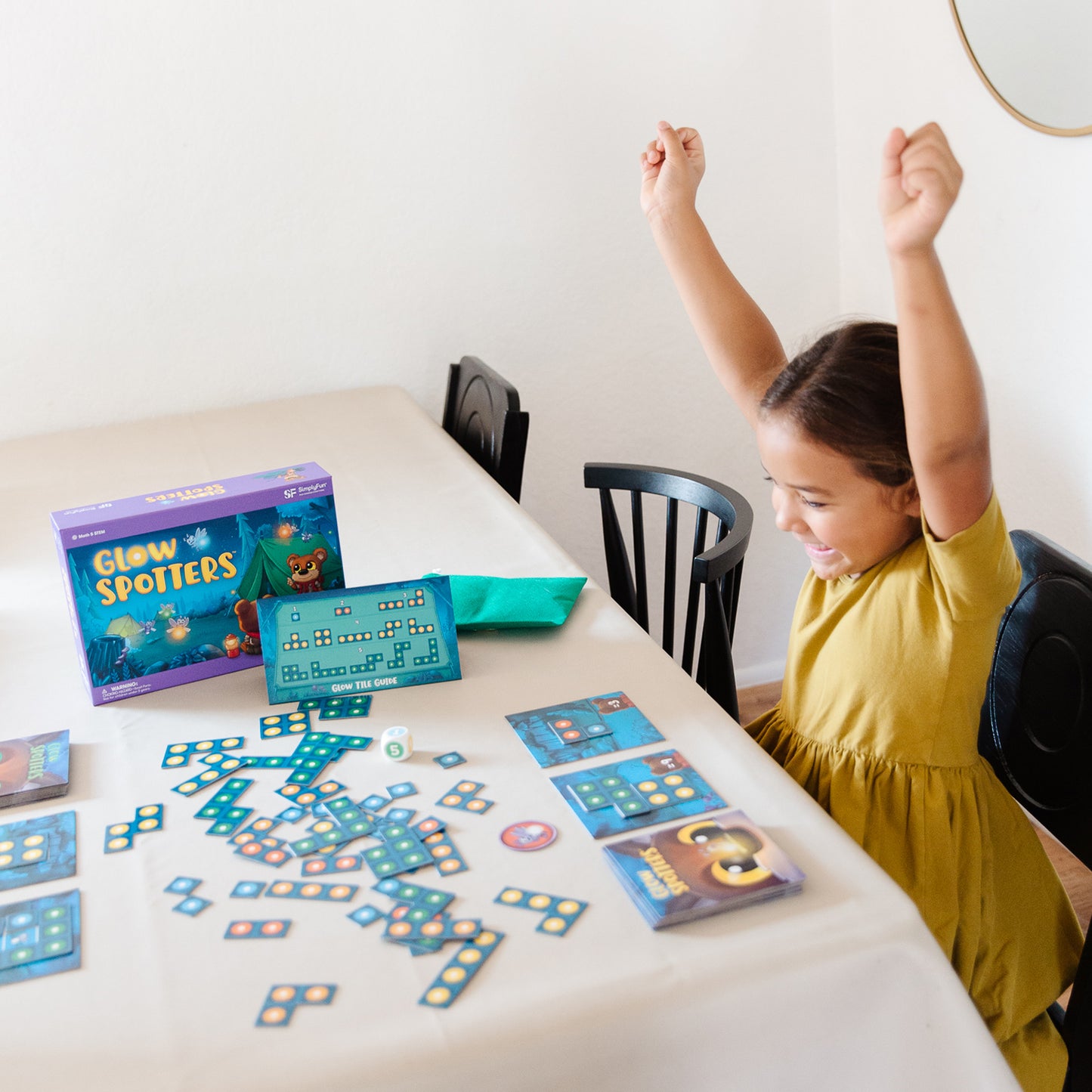
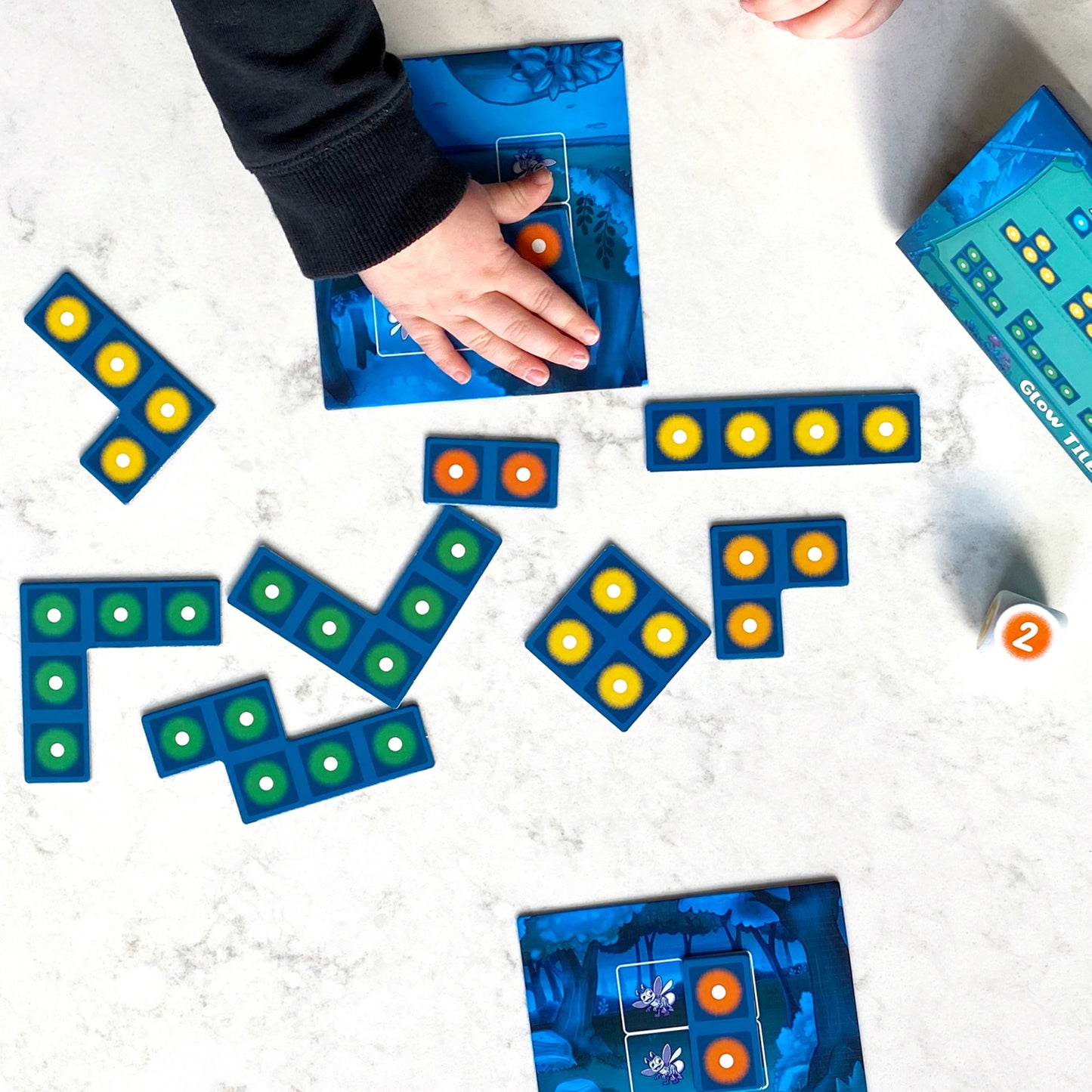
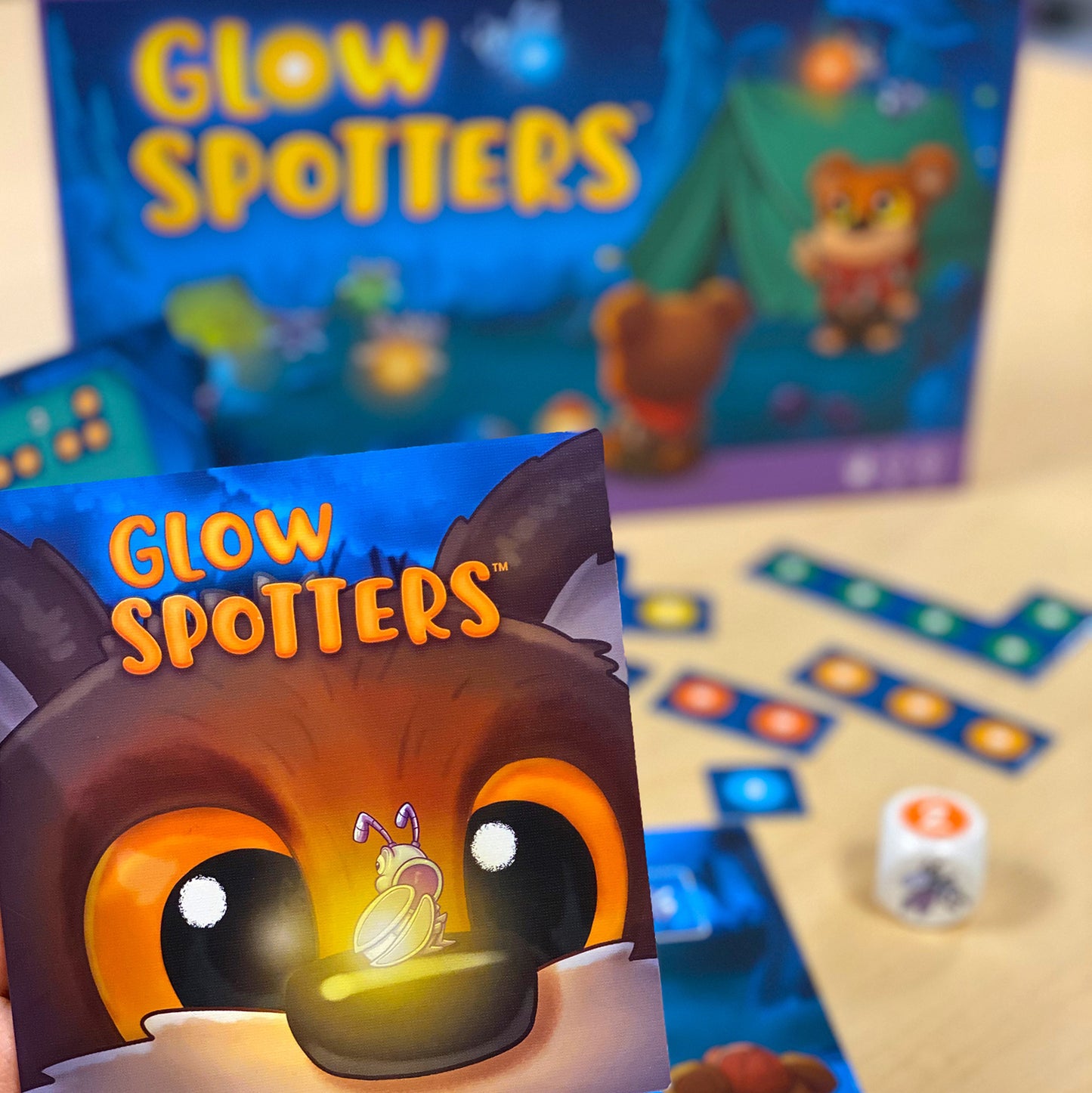
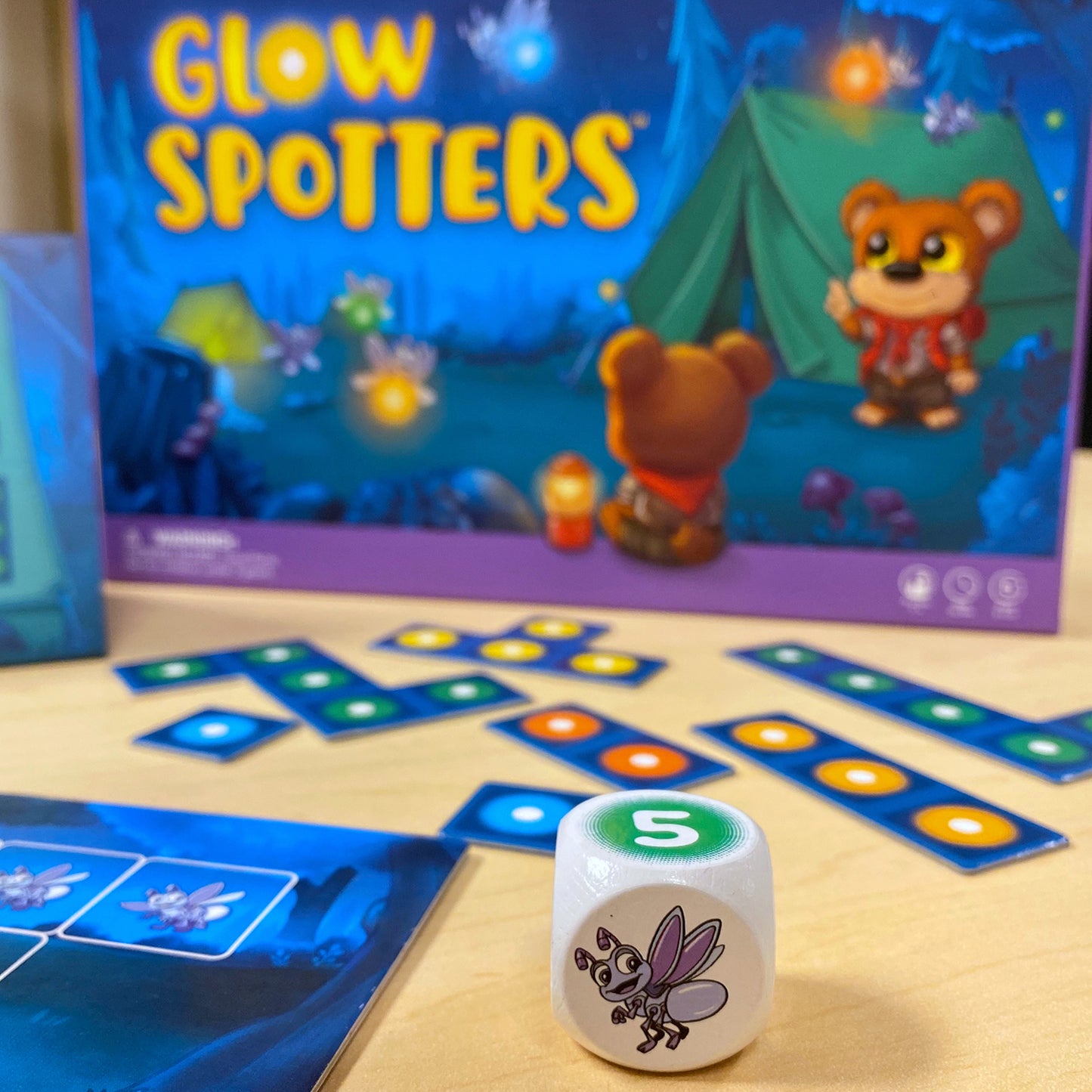
Collapsible content
How to Play
Educational Standards
Core Standard*: Math
Math
- Counting and Cardinality
- Know number names and the count sequence: Grade Level K
- Count to tell the number of objects. Grade Level K
- Compare Numbers Grade Level K
- Operations and Algebraic Thinking
- Understand addition as putting together and adding to, and understand subtraction as taking apart and taking from. Grade Level K
- Work with addition and subtraction equations. Grade Level 1st
- Geometry
- Analyze, compare, create, and compose shapes. Grade Level K
- Reason with shapes and their attributes. Grade Level 1st
Skills
Explore
What Does Child Do To Use Skill In The Game?
Players need to examine the game area for Glow Tiles, and their Firefly Boards for where they can place a tile. When the Firefly is rolled on the game die, lead player also needs to look at all the other players' boards to determine which tile color to select.
How Parents Can Assist Learning
When the Firefly is rolled, parents can help children to make the best decision by suggesting that they "Wait. Look. Think." This will help them spend time considering different which tile color to select that will help fill out one of their boards, while preventing other players' from filling in their boards.
This will also help with impulsivity and planning. Using such verbal cues can give children a model for approaching future play.
Learning Implications and Educator Support
When the Firefly is rolled, educators can help children to make the best decision by suggesting that they "Wait. Look. Think." This will help them spend time considering different which tile color to select that will help fill out one of their boards, while preventing other players' from filling in their boards.
This will also help with impulsivity and planning. Using such verbal cues can give children a model for approaching future play.
Determine
What Does Child Do To Use Skill In The Game?
Players need to decide on which tile to select that can their Firefly boards and in which orientation. Spatial match. When firefly is rolled.
How Parents Can Assist Learning
If you see a child struggling with selecting the best possible Glow Tile, allow the child to hold and manipulate each of tiles that match the color on the die. This will help the child to determine which will work best on their game boards.
Parents can say something like "Look at your boards. Is there any place this tile could go on either board? How about this one?" By breaking it down, the child has a better chance of making a correct decision.
Learning Implications and Educator Support
Like a puzzle or puzzle game, Glow Spotters involves a high degree of spatial orientation and matching.
When introducing the game, play without the die. Allow children to examine, pick up and experiment with orienting any tile in order to select one to place on their game boards. This will help develop their spatial orientation skills prior to playing the game when they are not permitted to pick up tiles prior to determining which one to pick.
Compare
What Does Child Do To Use Skill In The Game?
The comparing skill is used and sharpened simultaneously with the Explore and Determine skills as children need to compare spaces on their boards with the different Glow Tiles they may select.
How Parents Can Assist Learning
When the Firefly is rolled, parents can help children to make the best decision by suggesting that they "Wait. Look. Think." This will help them spend time considering different which tile color to select that will help fill out one of their boards, while preventing other players' from filling in their boards.
This will also help with impulsivity and planning. Using such verbal cues can give children a model for approaching future play.
Learning Implications and Educator Support
Like a puzzle or puzzle game, Glow Spotters involves a high degree of spatial orientation and matching.
When the Firefly is rolled, educators can help children to make the best decision by suggesting that they "Wait. Look. Think." This will help them spend time considering different which tile color to select that will help fill out one of their boards, while preventing other players' from filling in their boards.
This will also help with impulsivity and planning. Using such verbal cues can give children a model for approaching future play.
Solve
What Does Child Do To Use Skill In The Game?
Glow Spotters is usually straightforward as players need to use physical or mental reorientation to find a Glow Tile to fit a space on their boards. However, the Firefly on the die adds an extra dimension of strategic thinking. When it is rolled, lead player also needs to look at all the other players' boards to determine which tile color to select.
How Parents Can Assist Learning
When the Firefly is rolled, parents can help children to make the best decision by suggesting that they "Wait. Look. Think." This will help them spend time considering different which tile color to select that will help fill out one of their boards, while preventing other players' from filling in their boards.
This will also help with impulsivity and planning. Using such verbal cues can give children a model for approaching future play.
Learning Implications and Educator Support
When the Firefly is rolled, educators can help children to make the best decision by suggesting that they "Wait. Look. Think." This will help them spend time considering different which tile color to select that will help fill out one of their boards, while preventing other players' from filling in their boards.
This will also help with impulsivity and planning. Using such verbal cues can give children a model for approaching future play.
Review
What Does Child Do To Use Skill In The Game?
Players review by counting or completing a math equation to show that they have successfully filled in a Firefly Board.
How Parents Can Assist Learning
No special parent support needed.
Learning Implications and Educator Support
The directions indicate how to use Glow Tiles to create an addition equation. Educators may want to demonstrate how to use the tiles so that children do not merely count the glow dots on the tiles. Have the child lay the tiles on their board in a row, like an equation sequence. Encourage them to add on from one tile to the next without counting fireflies.
*Data compiled from CCSSI ELA Standards, WA Science Standards, and Washington Social Studies Standards
Special Needs
Cognitive
Suggestions for How to Modify Play Experience
If children are easily frustrated because of lack of spatial reasoning skills, let them partner with someone to play the game. A good comparison are puzzles. If children are overly challenged by puzzles, Glow Spotters may require some assistance to play successfully.
With two Firefly Boards to play, the child needs to shift attention back-and-forth and keep alternatives for both in mind. Playing with one card instead of two may allow the child to focus and decide which Glow Tile to select more easily.
When the Firefly is rolled, the lead player picks any tile they want. However, the other players do not. This will reduce the exploration, comparison and strategic thinking requirements.
Communication
Suggestions for How to Modify Play Experience
If children are nonverbal, they do not need to talk during the game, but they can demonstrate total number of Glow dots when they fill in a board by illustrating the addition with their fingers.
Encourage talking about options for placement of different tiles. Describe the tiles and their shapes. This will encourage children who are reluctant to talk to share their ideas with others.
Sensorimotor
Suggestions for How to Modify Play Experience
If children have fine motor concerns that prohibit them from manipulating the tiles, pair them with a player who does not have motor concerns. Encourage the children to collaborate and decide on tiles together, with the child with better motor skills manipulating the tiles for placement.
Social Emotional/Behavioral
Suggestions for How to Modify Play Experience
Children who have low motivation to succeed may give up easily. Encourage the child in a step-by-step manner, by asking them "What is the number on the die and the color of the tiles you need to look at?" "Look at your boards. Is there any place this tile could go on either board? How about this one?" By breaking it down, the child has a better chance of making a correct decision. This will build their self-confidence for playing the game without assistance.
Children who become easily frustrated may do better with a partner who can help point out possibilities and discuss options. This will make decision making less stressful for the child who is easily overwhelmed.
Vision
Suggestions for How to Modify Play Experience
The colors combinations on the materials may be a problem for some children. The green on blue and the light blue on dark blue may not provide enough contrast for some children with vision concerns.
Hearing
Suggestions for How to Modify Play Experience
Children who are deaf or hard of hearing should still be able to play Glow Spotters. They may need to use sign language or gestures to communicate about various parts of the game.
*Data compiled from CCSSI ELA Standards, WA Science Standards, and Washington Social Studies Standards
Autism
Autism Strengths & Interests
Short Summary of Strengths & Interests
- Addition
- Spatial reasoning
- Flexible thinking
Is good at matching visual items
This game is not appropriate
Has a good memory for sensory details, including visual, touch, taste and smell
Is This Game Appropriate? No
Description
Players need to manipulate visual details to orient tiles into the spaces.
Has a good memory for words, phrases and dialouge
Is This Game Appropriate? No
Description
Memory for words, phrases, or dialogue is not needed in Glow Spotters.
Has a good memory for pictures, numbers and patterns
Is This Game Appropriate? Yes
Description
Players need to remember the number on the die and look for a tile that has that number in a pattern they can play on their boards. They also need to be able to think about what that tile pattern would look like in a different orientation.
Likes to put things in order or a sequence
Is This Game Appropriate? No
Description
Although there is no ordering of items in the game, there is a sequence of actions: rolling the die, looking for the tiles with the number of Glow dots indicated on the die, then placing the tile on one of their boards so it fits the spaces available.
Learns through visualizing or "replaying" actions in their mind
Is This Game Appropriate? Yes
Description
Visualizing is important in Glow Spotters, as players have to be able to visualize what the various tiles would look like if rotated and placed on their boards.
Likes activities with rules, such as math and phonics
Is This Game Appropriate? Yes
Description
Simple addition is needed in the game.
Is very concrete and literal
Is This Game Appropriate? No
Description
The game requires abstract thinking about the orientation of objects in space. If children have difficulty with this, they could be allowed to use the tile pieces to try different orientations on their boards with concrete manipulation.
Learns in small "chunks" (for example, phone numbers are 3 chunks of number xxx-xxx-xxxx that are combined together)
Is This Game Appropriate? Yes
Description
Each of the tiles contains a "chunk" of numbers that children need to mentally manipulate to determine the total number without counting with their fingers.
Is good at nonverbal reasoning and logic
Is This Game Appropriate? Yes
Description
Glow Spotters requires nonverbal reasoning about which shapes will fit into specific spaces on their boards. When the players throws the Firefly on the die, it enables them to select which number and tile they want, and other players must follow with the same number. This allows players to reason about which number will most help themselves or hinder others.
Likes spatial problem solving
Is This Game Appropriate? Yes
Description
Glow Spotters is a great game for spatial problem solving. It is the basis of the game. It helps players think about how different tiles or tile orientations may work in a specific space. If children like puzzles, they will likely love Glow Spotters.
Can read well with good vocabulary, though may not fully comprehend content
Is This Game Appropriate? No
Description
Reading is not needed for playing Glow Spotters.
Likes to use and has good fine motor skill
Is This Game Appropriate? Yes
Description
Players need to orient pieces on the boards, which requires fine motor skills, but precision is not needed. Other players can assist if needed.
Likes established routines or set ways of doing things
Is This Game Appropriate? No
Description
The routine of game play is the same with each turn, but players use different tiles and placements with each turn. Decision-making about options is important in Glow Spotters.
Likes manipulating, constructing or building things
Is This Game Appropriate? No
Description
Manipulation of tiles is important, but no construction is involved.
Likes to use and has good musical abilities
This game is not appropriate
Likes to use and has good drawing skills
This game is not appropriate
Autism Special Considerations
Appears to ignore other's communication and/or has difficulty giving eye contact to a communication partner
Is This Game Appropriate for Child with Characteristic? Yes
Can Child with Characteristic Play Game w/o Modification? Yes
Strategies for Developing Compensatory Skills:
The child does not need to listen to others' conversation to play Glow Spotters. Players do need to pay attention to their own board and the Glow Tiles left on the board to be able to choose a tile that will fit on one of the boards. Other players can point to the color of the pieces that the child needs to pay attention to.
Has difficulty understanding complex verbal directions
Is This Game Appropriate for Child with Characteristic? Yes
Can Child with Characteristic Play Game w/o Modification? Yes
Strategies for Developing Compensatory Skills:
Use the Reference Guide to demonstrate what each of the colors mean in relation to number. Before playing the game, walk the child through how to use the dice, choose a tile based on his boards, and lay it down. This will help the child learn the pattern of play.
Uses vocabulary inaccurately or demonstrates echolalia (repeating another's speech)
Is This Game Appropriate for Child with Characteristic? Yes
Can Child with Characteristic Play Game w/o Modification? Yes
Strategies for Developing Compensatory Skills:
Repetition of others should not interfere with the game play, but if other players are distracted by echolalia, give the child a fidget toy to play with until his turn. Imitation of others' words during play may actually help the child understand what is being done, as long as the child is paying attention to what is happening in the game.
Gets stuck repeating a verbal topic or physical actions and/or has difficulty attending to others' actions or topic.
Is This Game Appropriate for Child with Characteristic? Yes
Can Child with Characteristic Play Game w/o Modification? Yes
Strategies for Developing Compensatory Skills:
Children can best play the game if they watch the other players' moves, so they understand the remaining options for tile choices and can try to plan future moves. Adults can help by helping the child look at their boards and identify different tiles that would work in their remaining spaces.
Has difficulty producing speech/communication
Is This Game Appropriate for Child with Characteristic? Yes
Can Child with Characteristic Play Game w/o Modification? No
Strategies for Developing Compensatory Skills:
At the end of a round, the winner is supposed to say aloud the numbers that add up to the total on his board. If the child is nonverbal or has difficulty speaking, encourage the child to use fingers to show the numbers in sequence and the total.
Has difficulty sequencing multi-step actions and/or doing complex abstract tasks
Is This Game Appropriate for Child with Characteristic? Yes
Can Child with Characteristic Play Game w/o Modification? Yes
Strategies for Developing Compensatory Skills:
There are only three steps in a turn, throwing the die, picking a tile with the same number of spaces as is indicated on the die in a shape that will fit on one of their boards, and placing it in the correct orientation. The child may need step-by-step assistance for a few turns until the pattern of play is understood. The routine of play is the same for every turn, so that should make the child with autism more comfortable. The child may need a reminder to look at both boards for the best place to place a tile.
Demonstrates difficulty initiating and maintaining social interactions
Is This Game Appropriate for Child with Characteristic? Yes
Can Child with Characteristic Play Game w/o Modification? Yes
Strategies for Developing Compensatory Skills:
Social interactions are not needed in the game, but adults can model commenting on others' plays. Comment on tile choices, "That's a great choice! It fits right in there!"
Acts out or demonstrates avoidance behaviors when frustrated, overwhelmed, or needs more sensory input.
Is This Game Appropriate for Child with Characteristic? Yes
Can Child with Characteristic Play Game w/o Modification? No
Strategies for Developing Compensatory Skills:
If the game is too frustrating for one child, play as partners. Tiles are picked together and placement is discussed so the child is successful. Fidget toys between the child's turns may also help the child self calm.
Has short attention span for non-preferred activities
Is This Game Appropriate for Child with Characteristic? Yes
Can Child with Characteristic Play Game w/o Modification? No
Strategies for Developing Compensatory Skills:
Many children with autism like activities involving spatial relations such as puzzles or building toys. This type of game may be a good match. If the child does not like board games, playing as partners may be a way to demonstrate that the game is fun.
Needs sameness or consistent routines and/or has difficulty with transitions from one activity to another
Is This Game Appropriate for Child with Characteristic? Yes
Can Child with Characteristic Play Game w/o Modification? Yes
Strategies for Developing Compensatory Skills:
Each turn in Glow Spotters is played the same way, so it is consistent. This should feel predictable to the child. If moving from one activity to another is a problem, motivate the child by "finding" a piece of the game and having the child help you discover where the game is located. Once "found" the child may be motivated to play it.
Has difficulty understanding others' feelings, intentions, and the reasons for others' actions.
Is This Game Appropriate for Child with Characteristic? Yes
Can Child with Characteristic Play Game w/o Modification? Yes
Strategies for Developing Compensatory Skills:
Children don't have to understand others' feelings to play Glow Spotters. Other players, however, can support understanding by saying how they feel when they win a round, can't role the needed number on the die, or can't find the right shaped tile they need for their board.
*Data compiled from CCSSI ELA Standards, WA Science Standards, and Washington Social Studies Standards
Extended Play
Extra Ways to Play the Game
Change the rules so that when the Firefly is rolled on the die, the player can take a tile of their choice from another player.
Materials Needed
No additional materials are needed.
Developmental Benefits
The benefit of this option is that it forces players to demonstrate flexibility and resilience. They cannot be sure that their board will remain intact throughout the game, so they must always keep options in mind.
Extra Ways to Play the Game
Another option is when the Firefly is rolled, the player who is rolling the die may decide to tell all players to take a tile either from the player on their left or the player on their right.
Materials Needed
No additional materials are needed.
Developmental Benefits
The benefit of this modification is that all players need to keep an eye on all the other players boards, so they can anticipate what they might want to take when given the chance. This requires flexible thinking and tolerance for the unexpected.
*Data compiled from CCSSI ELA Standards, WA Science Standards, and Washington Social Studies Standards
Collapsible content
How to Play Video & Transcript
A visual math game where players join the Glow Spotters Troop on their nature adventure. Earn your Firefly Badge by spotting fireflies and adding the groups up to get the totals.
You can play Glow Spotters with 1-4 players, ages 5 and up.
Glow Spotters is good for developing Addition Skills. The ability to see numbers in patterns is the foundation of strong number sense and an important part of basic addition. Players use their Glow Tiles learning the various ways to reach the sums of 1 through 10.
Glow Spotters also helps with Spatial Reasoning Skills. Players use spatial reasoning in this multisensory experience, exploring numbers, visualizing them in different contexts, and relating them outside of formal written numbers.
Glow Spotters is very helpful for visual learners who process information they can see better than information that they hear.
Spread all the Glow Tiles in the middle of the play area, where everyone can reach them.
Place the die near the Glow Tiles.
Each player chooses a set of Firefly Boards, numbered 1 through 10. Everyone shuffles their boards and makes a facedown draw pile in front of themselves.
Assemble the reference guide and place it near the play area.
Place the Firefly Badge near the play area.
All players then turn over the top two Firefly Boards from their pile.
Players roll the die and collect various-shaped Glow Tiles to fill number grids in order to reach the sum of fireflies on their board. The first player to complete all 10 of their Firefly Boards is the winner and earns their Firefly Badge!
This game is played in rounds. Each round the starting player rolls the die, revealing the number and color of the Glow Tile group that all players will collect from.
Glow Tiles are grouped by the color and number they represent. The numeral on the die tells you how many glow spots to look for on a tile and what color the tiles are for that group.
Beginning with the starting player and moving clockwise, everyone takes turns selecting and placing a Glow Tile on one of their faceup Firefly Boards. Once everyone has had a turn, the round is finished.
Then the starting player passes the die to the next player on their left. This player will be the starting player for the next round.
On your turn, choose one Glow Tile from the play area. Select a tile that is the same number and color as the die shows for the current round. If the firefly icon is rolled, the starting player may choose which number and color they would like, and all players will then pick from that same tile group.
Look carefully and choose a Glow Tile that will fit into one of the two grids on your faceup Firefly Boards. The tile may be flipped and rotated so that it will fit.
The tile needs to fit within the square spaces and is not allowed to extend beyond the grid.
A Glow Tile may not be placed on top of or overlapping another tile already in the grid.
Once a tile has been placed on a board, it may not be moved.
If there are no tiles available that fit correctly on either of your Firefly Boards, you may take and place a blue (1) Glow Tile instead.
Completing Firefly Boards
Some boards may require multiple tiles of different colors to complete the grid.
When all the grid spaces on your board are covered by Glow Tiles, your Firefly Board is completed.
Now say the equation that you just created to reach your sum out loud. For example, '1+1+3+5=10.'
Return the Glow Tiles from the completed board to the center play area and place the board back in the box.
Then turn over the top board from your draw pile so you have two Firefly Boards in front of you again.
Ending and Starting a New Round
After placing a Glow Tile or completing a board, your turn is over, and play continues clockwise with the next player choosing and placing a Glow Tile. Once each player has had a turn choosing a tile, the round ends. Then the starting player passes the die to the next player on their left. This player will begin the next round by rolling the die.
The game ends when a player has completed their last Firefly Board. This player is the winner and has earned their Firefly Badge!
Discover all the different ways you can add firefly glows to total the numbers on your boards in Glow Spotters!
- Choosing a selection results in a full page refresh.
- Opens in a new window.

